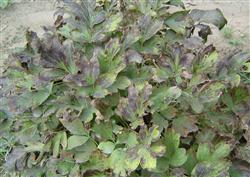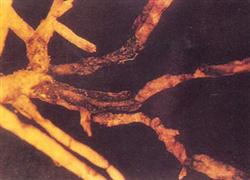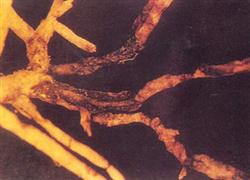How to raise peonies: what are the peony diseases and insect pests?

What are the peony diseases and insect pests? How to control peony diseases and insect pests? Ask netizens to help introduce and guide the main diseases and insect pests of peony are: Botrytis cinerea, brown spot, anthrax, wheel spot, branch blight, root-knot nematode disease, the following detailed introduction of the harm and control methods for netizens' reference. 1. The harm of Botrytis cinerea in peonies Botrytis cinerea is one of the most important diseases of peony in the world, which occurs frequently in China, especially in Shanghai, Zhengzhou and other places. The disease can occur in the growing season of tree peony and does serious harm to young plants, causing lodging and wilting of seedlings. Prevention and control of Botrytis cinerea in peony flowers: first, reduce the source of infection: remove the dead branches and leaves of diseased plants in autumn, remove diseased buds and diseased leaves in spring, and bury the diseased remains deeply. Method 2. Chemical control in the growing season: once the disease occurs in the growing season, the following agents can be used for spray control: 1% lime equivalent Bordeaux solution, 70% methyl topiramate 1000-fold solution, 65% Dysen zinc 500-fold solution, or 50% clonitramine 1000-fold solution. Spray once every 10-15 days, 2-3 times in a row. Method 3. Strengthen cultivation management: planting density should be moderate; drainage should be timely after rain, and wet soil should not be cultivated at the base of the plant clump; crop rotation should be carried out in seriously diseased areas; disease-free seedlings should be planted, and the seedlings can be soaked in 65% zinc 300 times solution for 10 minutes. 2. Peony brown spot is harmful to brown spot, also known as red spot, which is a common worldwide disease of peony. It often causes early withering of leaves and affects the growth potential of peony. Prevention and control methods of peony brown spot: first, reduce the source of infection: thoroughly remove the disease residue on the ground in autumn; spray 50% carbendazim 600 times solution or 3-degree stone-sulfur mixture before germination in early spring to kill the bacteria on the plant. Method 2. Chemical control in the growing season: spray 50% carbendazim 1000 times solution, or 65% Dysen zinc 500 times solution, spray once in 7 days-10 days, 3-4 times successively. Method 3. Strengthen cultivation management: moderate planting density, application of organic fertilizer and compound fertilizer. 3. The harm of peony anthracnose anthracnose is a common disease of peony in China. Anthracnose often causes peony leaves to be withered, the diseased stems are twisted, and young branches die. Prevention and control of peony anthracnose: method 1, reduce the source of infection, the same as peony brown spot. Method 2. Chemical control of the growing season: spray 70% anthrax 500 times solution, or 1% lime equivalent Bordeaux solution, or 65% Dysen zinc 500 times solution at the initial stage of the disease (May-June). 10-15 days once, a total of 2-3 times. 4. The harm of peony flower ring spot disease, also known as white star disease, is also a common leaf spot disease of peony, mainly harmful to leaves. When the disease occurred, the disease spot on the leaf was reticulate or nearly round, with a large number of 4~10mm in diameter, light brown to grayish white, and the edge was brown. The old disease spot had obvious gray-black mildew in the center of the disease spot, that is, the fruiting body of the pathogen. Prevention and control of peony mosaic spot: first, reduce the source of infection: remove the fallen leaves of diseased plants in time, spray 3-degree stone sulfur mixture before plant germination to kill the bacteria on tree peony plants. Method 2. Chemical control during the growth period: spray 1% lime equivalent Bordeaux solution, or 50% acetaminophen 800 times solution, or 65% Dysen zinc 500 times solution. After the onset of the disease, the patients were sprayed continuously for 2-3 times (once a day for 10 days-15 days). Method 3. Strengthen cultivation management: suitable planting density, good ventilation and light transmission. 5. The harm of peony flower branch blight infects the stem, branch and other parts of peony. The disease on the stem was a light brown spot, which gradually expanded to a reddish brown oval spot. The disease spot can circle the stem for a week, so that the branches above the disease spot die quickly. In autumn, small black dots appear on the disease spot, which is the conidium of the pathogen. The buds became brown after infection, and the dead buds could remain on the plants for a long time. The disease is caused by fungi. Disease conditions: pathogens mainly invaded from the wound. A large number of wounds and weak plant growth are conducive to the occurrence of diseases. Prevention and control methods of peony branch blight: ① strengthen cultivation management, enhance growth potential, reduce wounds and improve disease resistance. ② chemical control: see peony brown spot. 6. The harm of peony root-knot nematode disease the occurrence of peony root-knot nematode disease is common, which has been reported at home and abroad. In the past 10 years, root-knot nematode disease has become the most important root disease of tree peony in China, causing early defoliation. When the disease was serious, the leaves of peony were all bare in August. It occurs year after year, with dwarf, small leaves, small flowers or no flowering on the plant. Methods for prevention and control of root-knot nematode disease of peony 1. Strengthen quarantine to prevent the expansion of the epidemic area: the diseased vaccine found in the introduction work must be treated: soak in 0.1% isophosphate for 30 minutes, or soak in warm water of 48 ℃-49 ℃ for 30 minutes. Method 2. Chemical control in the field: 15% aldicarb granules were applied at acupoints, 5g-10g per plant, hole depth about 10cm. The drug was used in early May (Beijing), once a year. Method 3. Pre-control method of disease: disinfect with heat or pesticide. Commonly used pesticides are bromane, aldicarb, clenophos and so on. The soil can also be dried and sterilized at high temperature, such as basin soil dried for 30 days (water content up to 0.17%) without nematode survival. Click to get more peony planting techniques click to get more flower planting techniques
- Prev

How to raise peonies: what is peony purple feather disease?
What is peony purple feather disease? What harm does purple stripe feather disease have to peony? Also ask friends to help introduce the harm of purple feather disease of peony: commonly known as purple or black root rot, is a common fungal disease of peony. The incidence of old plants and continuous cropping for many years is higher, which also harms forest fruit trees and trees in addition to peony.
- Next

How to raise peony flowers: how to prevent peony rotten roots?
How to prevent peony rotten roots? Where to start prevention? Please also ask netizens to guide peony rotten root reasons: peony is deep-rooted fleshy root, afraid of long-term ponding, usually watering should not be too much, to be properly dry. Peonies like dry, well-drained soil. Succulent taproots and lateral roots. The first root is white...
Related
- Fuxing push coffee new agricultural production and marketing class: lack of small-scale processing plants
- Jujube rice field leisure farm deep ploughing Yilan for five years to create a space for organic food and play
- Nongyu Farm-A trial of organic papaya for brave women with advanced technology
- Four points for attention in the prevention and control of diseases and insect pests of edible fungi
- How to add nutrient solution to Edible Fungi
- Is there any good way to control edible fungus mites?
- Open Inoculation Technology of Edible Fungi
- Is there any clever way to use fertilizer for edible fungus in winter?
- What agents are used to kill the pathogens of edible fungi in the mushroom shed?
- Rapid drying of Edible Fungi

